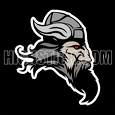pics
 The Norse myths
The Norse mythsWhen the Vikings first came to Britain, they had their own religion and worshipped many different gods. The stories they told about them are known as 'the Norse Myths'. They are mostly about contests between the gods and the giants.

Thor, the god of thunder trying to prove his strength to the Giant King by attempting to lift a giant cat.
ODIN was the wise and mysterious 'All-Father', the ruler of the gods. He was the god of magic, poetry and war. He gave away one of his eyes in exchange for wisdom.
THOR was the most popular god. He ruled the skies, storms and thunder, and protected ordinary people. He had iron gloves, a magic belt and a hammer used as a weapon.
LOKI was the mischievous, dangerous trickster god.
FREYJA was the goddess of love, beauty and fertility. She herself was very beautiful and wept tears of gold and amber.
FREY was the god of fertility and Freyja's brother.
The Vikings and Christianity
England, Scotland and Wales had been Christian countries for a long time. As the years went by, most Vikings living in Britain also became Christians. However, some continued to follow their old religion at the same time. Many Viking lords founded new churches. They also put up stone crosses in churchyards all over Britain.
Discovering new lands
The Vikings were brave sailors and explorers. They thought nothing of taking their families on long, dangerous journeys across the sea. They discovered and settled in several remote countries that lay to the west of Britain in the north Atlantic Ocean: the Faeroe Islands, Iceland and Greenland.
A Viking man called Bjarni Herjolfsson discovered America by accident in the year 985, when his ship was blown off course on the way to Greenland. A few years later, in 1001, Leif Eriksson 'the Lucky' sailed there to take a proper look at it. He was the first European to land in America.
Viking houses
Most people lived on farms. Their houses were built of wood, stone or blocks of turf, with thatched or turf roofs.

Jorvik (modern York) was an important town in Viking Britain. Its houses were built of wood or wattle, crowded close together along narrow streets.
The end of the Viking age
Throughout the Viking Age, there were many conflicts and battles between the Vikings and the English.In the 9th century, the English king, Alfred the Great forced the Vikings to leave the whole of western England. During the 10th Century the English reconquered many Viking areas. But in the early 11th century the whole of England was ruled by the Viking King Knut.
In 1066 England was conquered by William, the Duke of Normandy. This was the end of the Viking Age in England.In Scotland, powerful Viking earls continued to rule the islands and some of the mainland for hundreds of years. They were driven from the mainland in the mid-12th century, but remained in the northern islands for another 300 years.
What the Vikings left behind
Archaeological remains
Archaeological remains can be found all over Britain. They include the remains of houses, burial sites, treasure hoards, stone sculptures and writing carved in 'runes'.
Language
Many familiar words such as 'husband', 'egg', 'law', 'knife' and 'window' originally came from the Vikings' language. Some days of the week are named after their gods: for example, Thursday is 'Thor's Day'.
Place names
Any place with a name ending in -by, -thorpe, or -ay was originally settled by the Vikings.
Stories
The Norse myths are still regularly retold today. The Vikings also left behind many stories about real people: these are called 'sagas'.
as seen on

0 Comments:
Post a Comment
<< Home